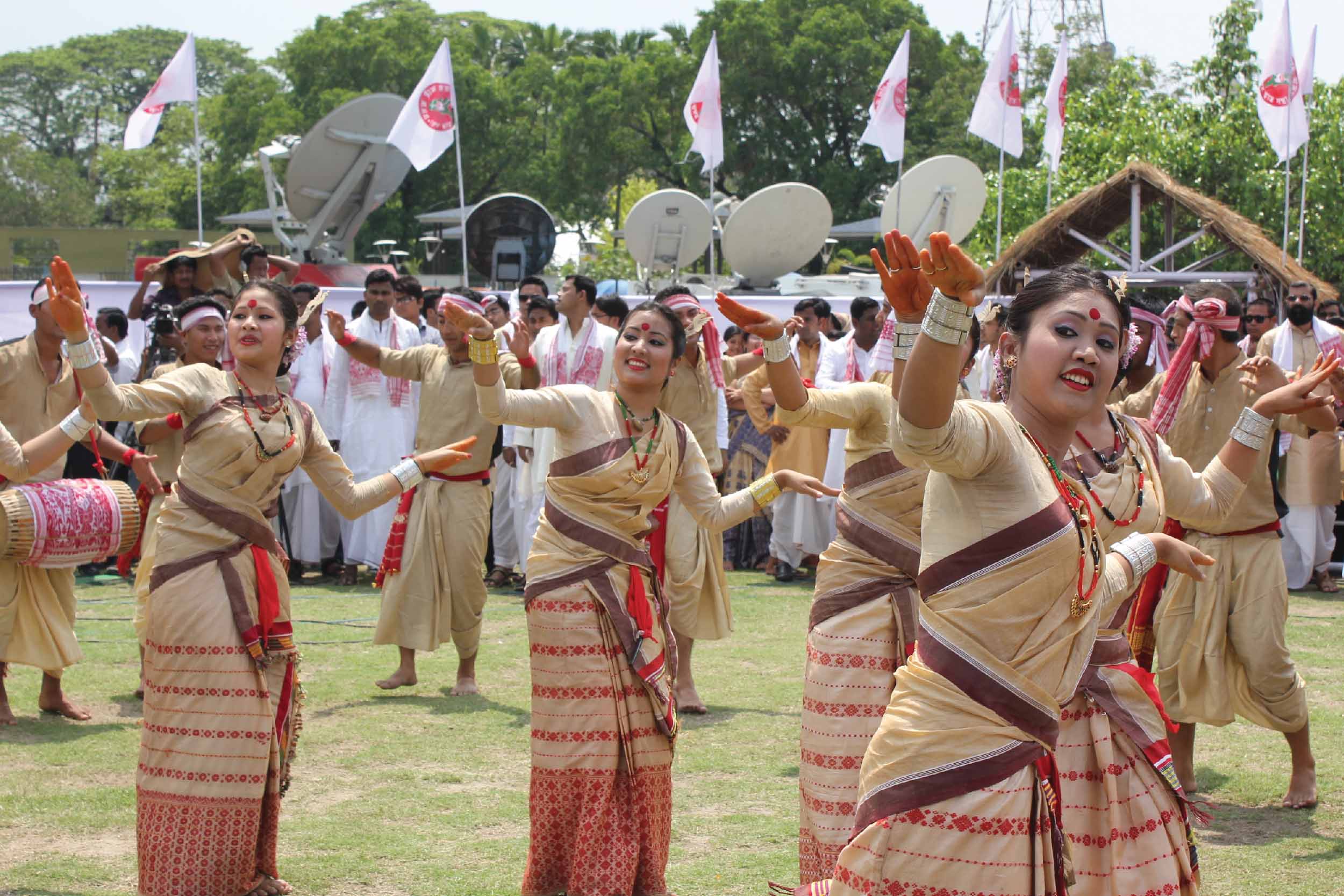Assam is one of the most beautiful, serene and vibrant states of India which is not only rich in nature, culture and tradition but extremely diverse in its festivities.
In India, festivals have a long history of bringing the community together and celebrating a life which is especially important in these modern times. Just like other states and cultures, Assam has numerous festival celebrations of its own which keeps Assam’s spirit up and high through-out the year. However, the festival which is more close to the heart of the Assamese is the harvest festival, Bihu.
There is an interesting myth associated with the origin of the name “Bihu”. The word is derived from the language of the Dimasa people and their supreme God is Brai Shibrai. Now the first cultivated crops of the season are offered to Brai Shibrai while wishing for peace and prosperity. So Bi roughly translates to ask and Shu means “peace and prosperity” in the world. Hence the word “Bishu” gradually became Bihu to accommodate linguistic preferences.
Bihu is predominantly associated with agriculture and is celebrated 3 times a year just around significant periods in the farming calendar. Each 3 Bihu festival has its own unique significance;
1. Bohag Bihu:
The first Bihu is known as Rongali Bihu or Bohag Bihu, which is celebrated mid-April April during spring which marks the first day of the year as per Hindu solar calendar.
Traditionally, men prepare the fields for cultivation of paddy and women make traditional food made of rice and coconut like “Pitha” and “Larus” which gives Bohag Bihu a real festive spirit of the season. Bohag Bihu is primarily celebrated in seven consecutive days and normally referred to as Shat
Bihu. The first day of the Bihu is called Goru Bihu, where the cows are cleaned and worshipped, which falls on the last day of the previous year, usually on April 15.
The second day is Manuh (human) Bihu, the New Year’s Day, a day of wearing new clothes, celebrating with family, friends & community and welcoming the new year with fresh vigour. The third day is Gosai (Gods) Bihu; statues of Gods, worshipped in all households are cleaned and people pray for a better, happier and prosperous new year. The fourth day, Kutum Bihu is when people visit family and relatives. Fifth Day of Bhogal Bihu is
called Senehi Bihu which is sort of like an Assamese Valentine’s Day. Senehi Bihu symbolises love and is a day when people meet their beloved and give gifts. The sixth day is Mela Bihu where local communities organise fairs and functions where people come together to mingle with each other and strengthen the bond of communal brotherhood. The Seventh and the last day of Bihu is Chera Bihu which marks the end of Seven days of Bihu
celebrations where the common practice is exchange food between families and neighbours with hopes and greetings of a happier new year for all.
Like many Indian cultures, Assam has folk songs associated with the Bohag Bihu, called Bihugeets or Bihu songs. The form of celebration and rites vary among different demographic groups.
Rongali Bihu is also a fertility festival, where the Bihu dance is performed with sensuous moves by young women calling out to celebrate their fertility. In this aspect, the Bihu dance can also be called a mating ritual by the young men and women.
2. Kongali Bihu
Also known as Kati Bihu, Kongali Bihu has a different way of celebrating as compared to other Bihu. This is during the harvesting period around mid-October. During this time, the paddy crops are in the phase of growing and locals usually celebrate this day by praying for safekeeping of their crops. People lit lamps made of clay at the foot of the tulsi plant to protect the maturing paddy, farmers whirl a piece of bamboo and recite Rewa
Khowa chants to ward off pests and the evil eye. Evenings are spent by feeding the cattle with specially made “Pitha” made out of flattened rice.
This Bihu is also associated with the lighting of akaxi gonga or akazbonti, lamps at the tip of a tall bamboo pole, to show the souls of the dead way to heaven.
3. Bhogali Bihu
After a long year of hard work and farming, one can’t help but celebrate all the efforts and results gained from it. That’s what Bhogali Bihu is about. Celebrated during mid of January, Bhogali Bihu marks the end of the harvesting season. The term “Bhogali” originates from “bhog” which translates to “eating” or “enjoyment”. Since the granaries are filled with crops and other harvests, people celebrate it with a great feast, peppy folk music and thrilling sports.
The evening of last day of Bhogali is called “Uruka” is when men, more particularly young men go to the fields, with a water body nearby, to construct makeshift cottage called with hay of the harvest fields “Bhelaghar” and light bonfire from firewood called “Meji”. Young boys wander in the dark to steal wood for fire and vegetable, just a traditional but harmless fun practise.
The entire “Uruka” is spent around a bonfire with people singing Bihu songs, beating dhols and typical kind of drums while there is community feasting everywhere with people exchanging sweets and greetings at this time.
The next morning people gather around to burn their mejis and throw pithas (a sweet made of flattened rice), and betel nuts to it, offer their prayers to the God of fire and mark the end of harvesting year. The entire day different types of sports like Buffalo- fight, Cockfight and last but not least,
moreover extremely rare to observe anywhere else in the world, Nightingale fights are held.
Assam is primarily an agricultural state with fields of Jute, Sugarcane, Fruits and not to forget lush green lands of tea plantation with the Brahmaputra river enriching the nearby fields with water and spirit of Assam. Throughout the year, one can experience centuries-old legacies of Assamese culture, art, cuisine and traditions along with exotic beauty of Brahmaputra river on a cruise, serene trek of green tea gardens and exciting wildlife safari but the Bihu festival is what primarily makes
Assam stand apart and gives it a distinctive identity when compared to other cultures in India. Make your next trip during Mid April, October or January for a 360° Assam experience. When is your plan?




















Leave a Reply
You must be logged in to post a comment.